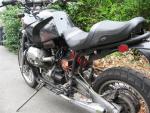Artikel aus Performance bikes
Guzzilla
Dynotec Moto Guzzi
158bhp, 105lb-ft, 168kg – from a Guzzi - what?
von Olly Crick
GERMANY'S Moto Guzzi tuning specialist, Dynotec, have produced a bike so engineeringly raw it's undeniably and exceptionally cool. It bristles with technical innovations and clever solutions to making a bloody fast bike from a lumpen V-twin motor that's been all but obsolete since the mid-1970s.
PB met Guzzilla at Hockenheim, which isn't the circuit it used to be. Gone is the famous forest section, replaced by a long left hander. This is worthy of note because there's no starter on this Guzzilla (one of nine that currently exist). You fire it up using a pit lane engine starter, MotoGP-style, and I'm terrified of stalling this high-compression monster on the tight hairpins that link it to the old track. Not just because there's no way of starting it again, but also because I'm really scared of dropping it as the revs die away on the slow apexes.
Dynotec began making Guzzillas in 1995 and continually develop more ideas for them. If you want one, they cost between 25,000 and 45,000 euros, depending how high a specification (and how much road kit) you choose.
The engine,originally a 1000cc unit from a Guzzi Daytona, is bored out to take 100mm diameter pistons. With a new 82mm stroke crankshaft, the capacity is hiked to 1288cc. To help the airflow keep up, 5mm larger inlet and exhaust valves have been slotted in. Dynotec fit their own special camshafts and a Sachs racing clutch. The extra stresses induced by all this mean the crankshaft requires bigger front bearings than stock, the pistons need stronger Carillo conrods and Dynotec's own uprated oil pump is fitted to stop everything disintegrating. The resulting lump makes a claimed 158bhp at 8400rpm and 105lb-ft at 6600rpm.
To force the maximum volume through the ram-air system (48 litres), the carbon fibre seat unit doubles as the airbox. The front bodywork, also carbon, channels air through the front hoops, straight into it.
The Moto Spezial fuel injection is hidden behind the side panels. The software it uses was developed on the Dynotec dyno. It's a closed loop system, so it's clean and efficient, too. The exhaust is also bespoke and carefully developed. There's a straight through 60mm diameter option that eliminates the bulky collector under the gearbox and releases another 5bhp. The front tubular sections are made from titanium, the rest are stainless steel.
The completely new steel chassis is hand built by Dynotec. The original Daytona item wasn't suitable or strong enough for Guzzilla's requirements. The new chassis has a 7cm taller seat height than the Daytona and a claimed 270 per cent stronger braced headstock. The head angle is 23.6 degrees and the wheelbase 1420mm, which makes Guzzilla's dimensions as sharp as an R6 and as long as a Mille R. The Dynotec aluminium swingarm is shorter than most at 480mm (a CBR600RR is 580mm), but Guzzilla feels stable at any speed.
Front brakes and both wheels are PVM. Calipers are top spec with titanium pistons, while magnesium wheels save unsprung weight and enhance the handling. The rear brake is a tiny PVM caliper off 125cc GP bike and a Dynotec 180mm disc, but with so much engine braking, a rear disc is hardly necessary.
The bike weights 168kg with everything bar petrol and is suspended by Öhlins front and rear. Dynotec worked closely with the swedish firm to ensure the suspension is just right and have mounted the rear shock without a linkage. Lots of wheel travel and shifting more oil improves damping, they say. The front 'superbike' forks come with a similar set-up to that used in the German superbike series. And it's works. Initial nerves are helped by slipping the clutch through those tight hairpins until I get used to it. The steering feels heavy to start with but the traction out of corners is phenomenal. The racing pattern l-up, 4-down gearbox made a fool of me a couple of times, but once the bike had my confidence I wanted one, and still do. Giving full power on the straights and tucking in behind the long fairing, you can feel every single throb of the engine. The sound it makes is indescribable, so I won't even try.
But it's not perfect and that's what I Iike about it, it has loads of character. It still sways like any other Guzzi when you rev it, it's too tall and doesn't feel like anything else. The raw unpainted metal on view is great. And it says Guzzi down each side. Spend an hour on www.dynotec.de and see if you feel the same. OC
Kontakt zu Autor(en)
Zurück
info@dynotec.de
Copyright © 2006 DYNOTEC GmbH


